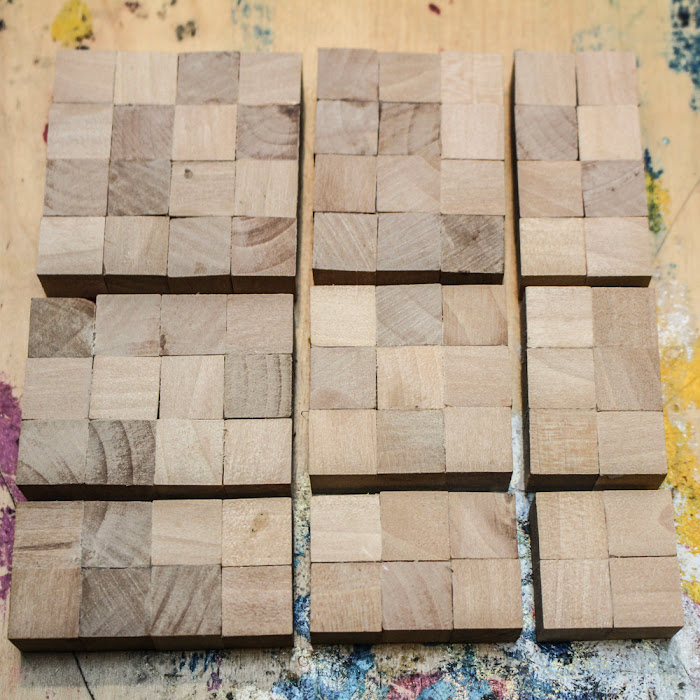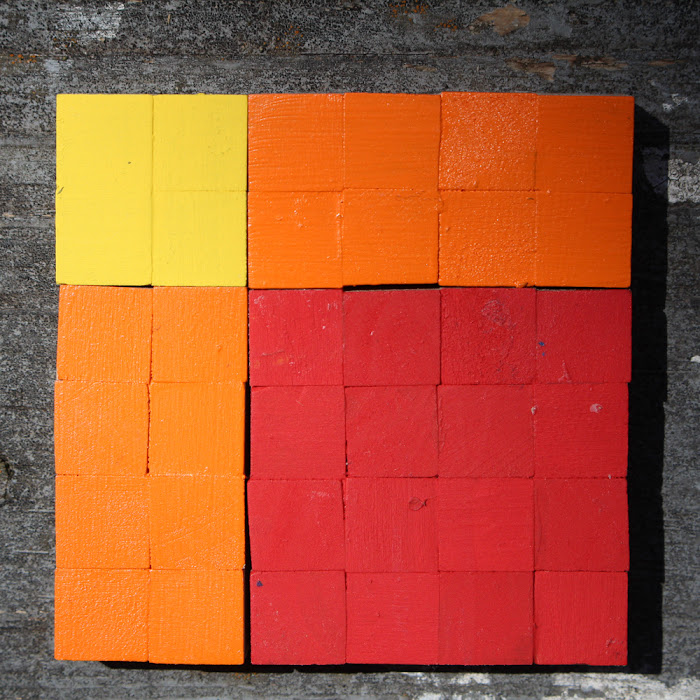
This trinomial square manipulative is an extension of the binomial square, and if you own a decanomial square manipulative you don't have to make this, because you've already got more than enough to model binomial and trinomial squares. I only made this a separate manipulative because I wanted its faces to match the DIY trinomial cube that I also built.
Because synergy!
I was a little bummed that I couldn't find enough cubes keyed to a centimeter standard to make my trinomial manipulatives in centimeter measurements. Instead, the smallest square in my DIY trinomial square is 1"^2, and the smallest cube in my DIY trinomial cube is 1"^3. So if you're trying to build a real Montessori-style trinomial cube, this is not the project for you. Keep searching for cubes measured in centimeters, or buy a zillion literal centimeter cubes and get to gluing! But because I started with inches, I was able to save myself some work when I made the trinomial cube by buying 1", 1.5", and 2" blocks, and gluing .5" blocks to them to make the prisms.
But that's a totally different project, which I made AFTER this. Here's how to make this project!
To make a trinomial square whose smallest square is 1", you will need the following materials:
- 81 blocks, each measuring .5"^3. I am profoundly devoted to Casey's Wood Products, and so I bought these .5" wooden blocks from them.
- acrylic paint in the primary and secondary colors. Sooo... red, yellow, blue, purple, orange, and green.
- glue. You can use wood glue, but it's not my favorite. I prefer E6000!
- paint brushes.
You are going to glue together the following rectangles. Remember that these are area models, not volume models, so don't be stacking any blocks on top of each other. Everything is just one block tall!
- 2x2 (you need one of these)
- 2x3 (you need two of these)
- 2x4 (you need two of these)
- 3x3 (you need one of these)
- 3x4 (you need two of these)
- 4x4 (you need one of these)
Here's what it should look like when it's finished!
If you did an exceptionally bad job gluing, you can pause and sand each rectangle smooth, but don't feel like you need to get caught in the weeds with this project--a few bumps and drips are fine. Nobody needs their trinomial square to look like it came from IKEA!
You are going to paint the faces that represent the areas of the trinomial square, and either paint the .5" tall faces black or leave them unpainted (I left them unpainted--no weeds for me!). If you want to keep your trinomial square at least Montessori-adjacent, then make your 1"^2 faces yellow, your 1.5" faces blue, and your 2" faces red.
Here's another big veer away from Montessori-style: I painted the area models that are adjacent to the squares the secondary color represented by combining the primary colors of those two squares. I think it makes logical sense, and it's pretty!
As another optional step, you can seal these, but if you used acrylic paint and your kids aren't going to play roughly with them, you don't have to.
The main purpose of this manipulative is to illustrate (a+b+c)^2. You can go through a billion machinations to expand this trinomial square via calculations, but just by looking at this physical model and copying what you see, you can clearly see that it's a^2 + b^2 + c^2 + 2ab + 2bc +2ac.
How much sense does that make, and how easy is that to remember?
Here's the entire trinomial square lesson that I do with my kiddos. We tend to spiral in our math projects, so ages ago the kids built binomial squares to practice pattern-building and to see what equations with variables look like. We delved back into it when Will's algebra curriculum started factoring. We're back again because now it's Syd studying algebra and Will studying geometry, and this makes a lovely intersection. To add interest and rigor, I introduced trinomials, and next time we find our way back to it, I imagine that we'll find something else new to explore!
Speaking of something else new to explore: here's another fun bit of spatial reasoning play that you can do with a trinomial square: it's a puzzle! We know how to make a perfect square one way, but how many other ways can you find?


These perfect squares should look familiar, because they're binomial square models!
If you enjoy this type of puzzle, you should really check out pentominoes. I am low-key obsessed with them--honestly, I can't imagine anyone who's a visual learner or enjoys spatial reasoning who wouldn't go mad for them!
P.S. If you need an anchor chart or a poster for display, there's a good graphic of the trinomial square and its measurements here.
P.P.S. Want to see more handmade homeschool stuff, and the adventures that we have with them? Check out my Craft Knife Facebook page!




